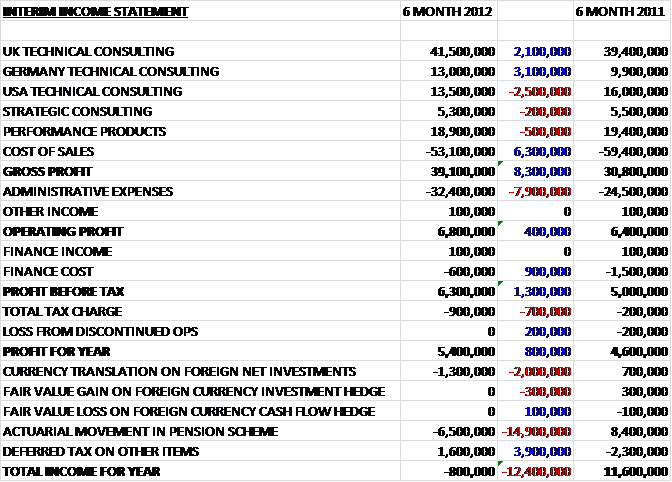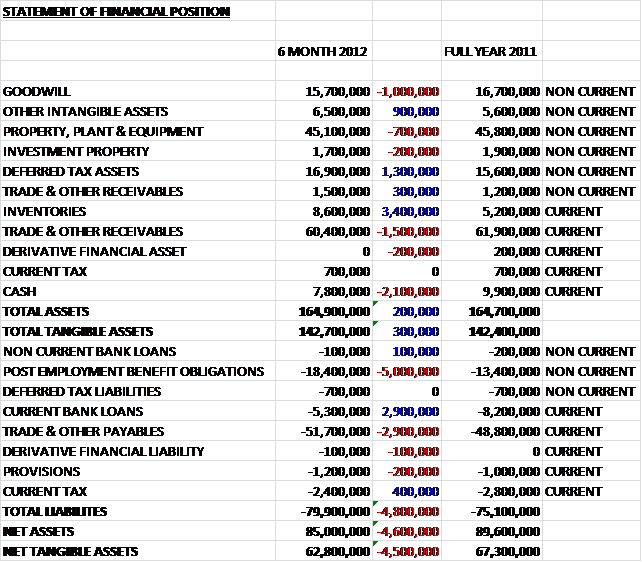
Dechra House, Jamage Industrial Estate, Talke Pits, Stoke on Trent, ST7 1XW
Next up for my shares blog is Dechra Pharmaceuticals. Dechra is an international pharmaceutical business focussed on the veterinary market with its key area of specialisation being the development and marketing of companion animal products and their business is split into several segments:
Product Development
This segment deals with the ongoing development of their specialist branded vet products and the group has a programme to increase its current product portfolio. They are looking to develop prescription only vet medicines targeted towards dogs, cats and horses. These products generally utilise technology already existing in the human market. Dechra are also developing pet diets for cats and dogs that have been diagnosed with various medical conditions and unlicensed medicines such as shampoos and supplements for dogs, cats and horses.
European Pharmaceuticals
This segment comprises Dechra Vet Products Europe and Dales Pharmaceuticals
US Pharmaceuticals
This segment comprises of Dechra Vet Products US
Services
This segment comprises of National Vet Services, Nationwide Labs and Cambridge Specialist Lab Services.
They operate in the following areas:
Dermatology
Canaural is sold in the EU and is a treatment for otis externa in cats and dogs; Fuciderm is sold in 23 countries and is a treatment for dermatitis and intertrigo in dogs; Malaseb is a shampoo for treating skin complaints in cats and dogs caused by Malassezia and Staphylococcal infections; Animax is sold in the US to treat skin conditions in cats and dogs and Dermapet treats various skin conditions in cats and dogs.
Endocrinology
Endocrine disorders is apparently a key focus for the group and they have Vetoryl which treats Cushing’s Syndrome in dogs internationally and Felimazole which treats feline hyperthyroidism in various international territories
Equine Medicine
Equipalazone is an anti inflammatory drug for the treatment of musculoskeletal disorders and Equidone is for the treatment of fescue toxicity in horses and is marketed in the US.
Ophthalmology
Fucithalmic Vet treats conjunctivitis and is sold in 21 countries. There are also 6 products marketed in the US.
Critical Care
There are a number of products that support emergency medicine, which are predominantly sold in the UK
Others
Dechra also manufactures and sells Pet diets, over the counter vet care products, generics and some marketing agreements to sell products through global subsidiaries.
DVP EU
This is the business unit that sells and markets Dechra’s own branded vet products within 13 European countries and manages the relationships with their worldwide marketing structure. Their products are mainly sold to vet surgeons working out of commercial vet practices.
Dales
Dales is the manufacturing arm of Dechra and manufactures the vast majority of their own brand products. It also makes money manufacturing pharmaceuticals for third parties, mostly in the human pharmaceutical sector. Most of the manufacturing is done in the UK but there is a small plant in Denmark too.
DVP US
DVP US sells and markets Dechra’s own branded products in the US. Their market is small animal and equine vet surgeons operating out of commercial vet practices.
NVS
NVS supplies and distributes vet products to vet practices around the country and is basically the distribution arm of Dechra. They also develop pharmaceutical stock management IT systems for vet practices.
Labs
NWL provides a first referral lab services to the vet industry covering various areas. CSLS provides a secondary referral service within the area of endocrinology. The customers for the lab services are UK commercial vet practices (both companion and large animal).
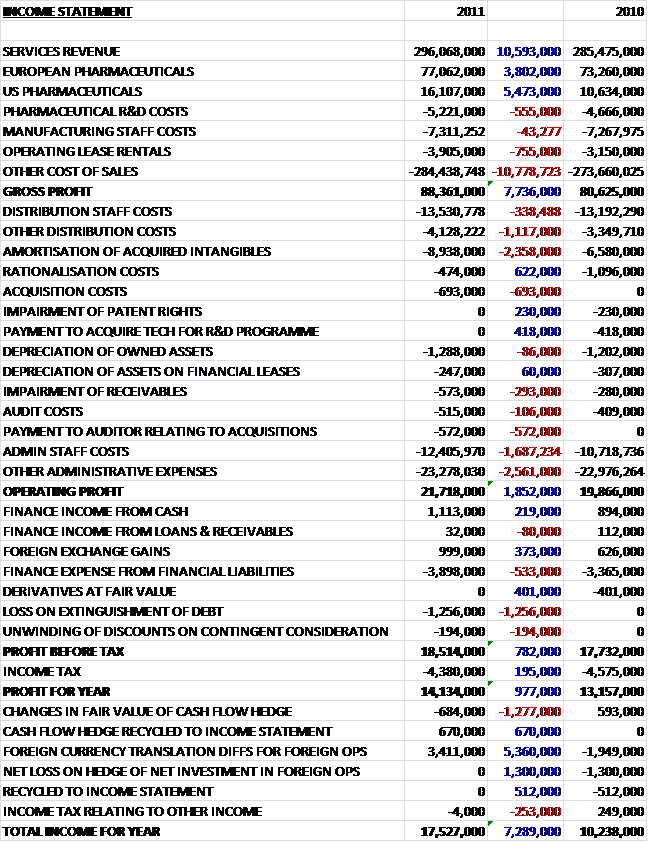
This looks fairly solid. The profit for the year is up nearly £1M to £14.1M and apparently the underlying profit margin is up from 7.6% to 8.2% due to the increase in the pharmaceutical business. We can see that revenue is up across all sectors (nearly £20M in total). I am not sure how much of this is due to the acquisitions but I would assume a lot of the £5.5M increase in the US is due to Dermapet (with a small increase due to the increased contribution of Vetoryl). The cost of sales and admin expenses are also up, however (£11.6M and £3M respectively) and there is a £1.7M increase in staff costs mainly due to investment in the US business, which will presumably increase more next year when the full year of the acquisitions is taken into account. There were acquisition costs of nearly £700K and although quite low, the impairment of receivables pretty much doubles to £600K so this is something I hope management are keeping an eye on.
Profit in the European pharmaceuticals business rose by 5.1% in the year, mainly due to the increase in the performance of the own branded products. Sales in diets are up 8% but diet margins are down somewhat due to an increase in raw material costs. In the services sector, IVS (the distribution arm) showed an increase in profit while the lab business showing a reduction in revenue but they have developed a new product for vet practices to easily test blood samples which it is hoped, will increase sales. Dales, the manufacturing arm was up slightly with a planned reduction in the manufacturing for their largest client offset by bringing more pharmaceutical product manufacturing in-house.
Otherwise we see the amortisation of acquired intangibles, which are up £2.4M to nearly £9M. This is quite a large charge in my opinion and may suggest an overpayment of previous acquisitions. It should be noted that this is not a cash charge, however. Rationalisation costs in 2011 related to the integration of the Dermapet and Gentrix, while the larger costs seen in 2010 relate to the closure of the Shewsbury warehouse and transfer of pre wholesale logistics to Denmark. The impairment of product rights noted in 2010 relate to the abandoning of an equine development product due to disappointing clinical trials. Distribution costs are up £1.5M to £17.7M which is mainly due to rising fuel costs and increased volumes.
The total income for the year is up substantially, mainly due to a favourable exchange rate relating to foreign operations.
EPS and P/E Ratio
I am now going to have a look at the EPS and the corresponding P/E Ratio.
| EPS |
2011
|
|
2010
|
|
|
|
|
| PROFIT AFTER TAX |
14,134,000
|
977,000
|
13,157,000
|
| NUMBER OF SHARES |
66,474,490
|
336,590
|
66,137,900
|
| EPS |
21.3
|
|
19.9
|
| SP |
490
|
|
385
|
| P/E |
23.0
|
|
19.4
|
Taking today’s share price, the P/E is 23.2, which is rather expensive but various analysts expect the EPS next year to be about 38.07, leaving the forward P/E at 12.9, which is much better value – these figures are based on the new business integrating well and giving some decent profit so if these analysts are to be believed, these shares are looking rather cheap when compared to the historic values but if this increase in profit doesn’t materialize, the opposite is true and the shares are a little dear.
Now to look at the Balance Sheet
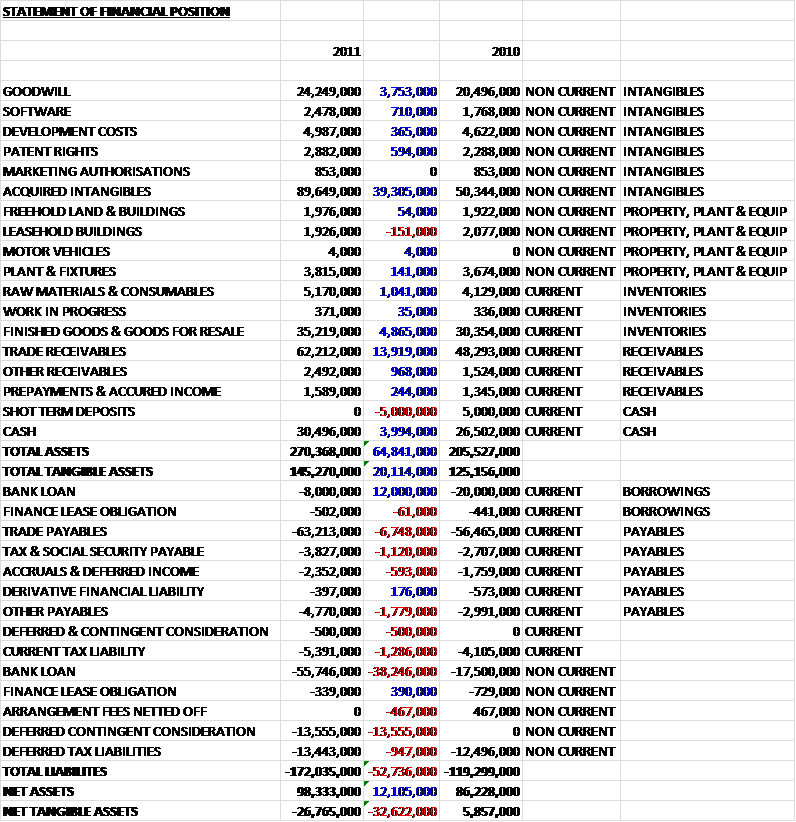
A bit of a mixed bag here. Obviously these figures are largely going to be affected by the acquisition of Dermapet but let’s see what the situation is. The net asset level of £98.3M has increased by £12.1M on the level of last year but a glance at the net tangible assets sees a £32.6M decline to leave a negative value of £26.8M. This in itself is not a terrible thing but I must say it makes me a bit nervous and would rather see a bit of a beefier asset list. Looking at these intangible assets we see that Goodwill has increased to £24.2M. I have noted before that I am not really a big fan of large amounts of Goodwill as it is by nature rather subjective and when it comes down to it is not really worth anything but the figure seen here is not that excessive. The really big number is the Acquired Intangibles. This has jumped £39.3M to £89.6M and this really gives a gloss to the net asset numbers that also makes me a bit uneasy. This leap is related to the acquisition and is for the product rights purchased along with the companies.
Moving on to tangible assets, the tangible assets are up just over £20M to £154.3M, within this figure the inventories are up nearly £6M, which were due to ensuring continuity of supply during the transfer of our diet range to a new manufacturer, higher revenues and additional payment terms offered to a major NVS customer. Trade receivables are up nearly £14M to £62.2M. This could be good or bad depending on whether it is caused by larger orders or slower payment from customers. Given the new payment terms mentioned above and the increase in revenues, I suspect it is a bit of both. Cash levels are up slightly to £30.5M but this increase is wiped out when the £5M reduction in short term deposits are taken into account.
On the flip side of the steady cash level we see that loans are up. Short term current loans are actually down £12M to £8M but the longer term loans are up over £38M to £55.7M. These loans were mainly used to fund the acquisition of Dermapet and given the low levels of tangible assets, it would be my preference to target a reduction in these loans. Trade payables are up £6.7M to £62.2, which is less than the increase in trade receivables and the tax liabilities seem rather high – current tax liabilities are £5.4M and deferred tax liabilities are £13.4M. I am not sure why they are quite so high, I would have thought the R&D work that Dechra do would contribute to a lower taxation amount. I think there are several countries where tax is paid, however, and the acquisition of Gentrix also acquired over £1M in tax liabilities.
The last item of note, I think is the deferred contingent consideration of £13.6M. This is clearly due to the recent acquisitions and I am not sure the time frames that it needs to be paid off but it shouldn’t break the bank. This all leaves total liabilities to be £172M, as noted earlier this is higher than the total tangible assets.
Cash flow:
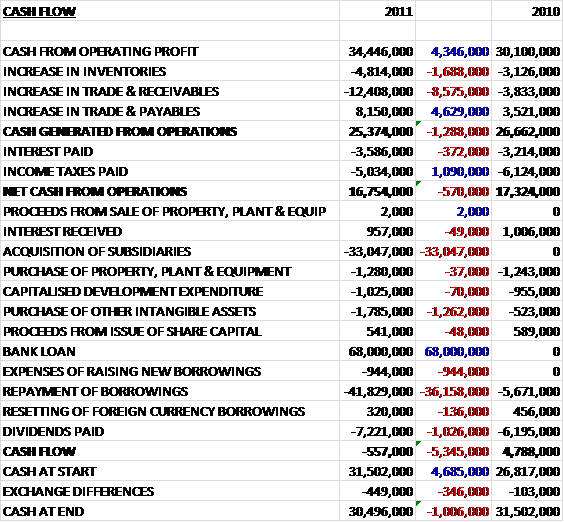
So, the headline figures show a slightly negative cash flow of -£600K, which is a reduction on the last year of £5.4M but there has been such a skewing of the figures from the new loans and acquisitions that it is not that helpful to compare the total figure.
There was £33M paid in cash for the acquisition, which was backed up by new bank loans to the tune of £68M (plus about £1M in costs to arrange the new borrowing). This in turn, is somewhat negated by the repayment of £41.8M of loans. So, a quick sum up shows that were it not for the acquisition, the company would have a positive cash flow. In fact, during the second half of the year, after the acquisition there was a net cash inflow of £15.5M, which is encouraging.
Looking into the operational cash flow, we see that inventories increased by £4.8M and trade and receivables increased by £12.4M while trade payables increased by only £8.2M (at the end of the year the group had an average of 60 days outstanding on purchases compared to 71 days the previous year) so there is more cash tied up in inventory and later payments from customers (and larger orders). Indeed, the amount of receivables overdue were £7.7M in 2011 compared to £4.2M in 2010 so this is something that I hope the group will keep an eye on.
So, this negative cash flow is not all that alarming given the large acquisition so it will be interesting to see how it fares in the next set of updates.
I think that the next couple of years will be dominated by the acquisition of Dermapet, and to a lesser extent , Gentrix so I have listed the details below.
| ACQUISITIONS |
|
|
|
| DERMAPET INC |
01/10/2010
|
|
|
| FAIR VALUE TO GROUP |
|
|
|
|
|
| INTANGIBLE ASSETS |
38,909,000
|
| INVENTORY |
384,000
|
| TRADE & OTHER RECEIVABLES |
1,084,000
|
| PAYABLES |
-217,000
|
| GOODWILL |
326,000
|
| NET ASSETS |
40,486,000
|
|
|
| SATISFIED BY: |
|
|
|
| CASH |
27,519,000
|
| DEFERRED CONSIDERATION |
1,163,000
|
| CONTINGENT CONSIDERATION ARRANGEMENT |
11,804,000
|
| TOTAL |
40,486,000
|
|
|
|
|
| DERMATOLOGICAL PRODS FOR PETS |
|
|
|
|
|
|
|
| GENTRIX LTD |
01/12/2010
|
|
|
| FAIR VALUE TO GROUP |
|
|
|
|
|
| INTANGIBLE ASSETS |
184,000
|
| PROPERTY, PLANT & EQUIPMENT |
23,000
|
| TRADE & OTHER RECEIVABLES |
326,000
|
| INVENTORY |
217,000
|
| CASH |
59,000
|
| IDENTIFIABLE INTANGIBLE ASSETS |
5,596,000
|
| PAYABLES |
-318,000
|
| DEFERRED TAX LIABILITIES |
-1,546,000
|
| GOODWILL |
1,845,000
|
| NET ASSETS |
6,386,000
|
| SATISFIED BY: |
|
|
|
| CASH |
5,586,000
|
| CONTINGENT CONSIDERATION ARRANGEMENT |
800,000
|
| TOTAL |
6,386,000
|
From this we can see exactly what Dechra paid for their acquisitions. As touched on earlier in this report, I think the intangibles here are rather high and there are not many tangible assets acquired with these companies. Indeed Gentrix comes with a deferred tax liability of over £1.5M. The other point of interest, I believe, is the contingent consideration. Dechra may be obliged to pay out over £12.5M more on these acquisitions. For Dermapet, these obligations are payments of US$1M due on the 2nd and 4th anniversaries of the completion date; US$15M payable between the 2nd and 6th anniversary or completion if Dermapet achieves in excess of $15M in any rolling 12 month period, and a further US$5 will become due if revenues exceed $20. This ties Dechra into payments for a considerable potential period. For Gentrix, the potential payments are more modest – £0.8M is payable on the achievement of specific milestones (not sure what they are).
Dermapet was a Florida based dermatological business and was purchased mainly to strengthen Dechra’s position in the US, which is the largest market for companion animal products. Genitrix was a privately owned company that operated solely in the UK and the intention here was top extend the Genitrix product range in to other EU territories. The Goodwill under the Dermapet acquisition relates to workforce and increased geographical presence in the US. The Genitrix goodwill relates to the workforce and associated technical expertise.
During the year, Dermapet was fully integrated and contributed nearly £2M to the operating profit of the group while Genitrix contributes quite a respectable £740K to profits during the year which given the total consideration paid for Genitrix and the fact that it was only contributed for part of the year is a very good return on investment.
This is not the first time the group has made a large acquisition, and it can be said that the last one has integrated well and helped Dechra grow in the way it has in previous years. However, I do have a note of caution. These acquisitions have pushed the net tangible assets into negative territory and there is clearly an increase in net debt to pay for them. Also, foreign (and in particular UK) companies tend to struggle in the US as there seems to be quite a protectionist attitude. BP, National Grid and Glaxo being high profile casualties, having run into problems in the world’s largest economy in recent years.
I think it is a case of wait and see how this goes.
Parts of the business have been affected by a decline in footfall through vet practices which has been offset in the UK by strong growth in the livestock sector and increase in vet products being purchased online. Dechra have various products being developed which should come online in the next few years that they predict will generate an extra £30M or so annually eventually. The group seem to be on a strategy to sell more of their products through subsidiaries. Despite the initial costs, this will enable Dechra to increase margins in these products.
The group is still very dependent on the UK but with the US acquisition and increasing sales in other parts for the world, this is slowly starting to change. No customer accounted for more than 10% of group revenues but there was one client who accounted for 13.1% of gross trade receivables. Despite the large loan, the payment terms seem fairly sensible and the bulk of the loan is payable in 2-5 years. A 2% increase in interest rates would reduce profit by £281K, which isn’t that much but in the medium term it may cause an issue should interest rates rise substantially. Dechra do seem to be quite susceptible to exchange rate changes, a 10% appreciation of GBP compared to Danish Krone would incur a £2.2M reduction in profit, a similar movement against USD would reduce profits by £2.5M and the same movement against the Euro would cause a £720K reduction in profit. While the former two movements are rather unlikely in my opinion, the latter is certainly possible and the figures quoted here are quite substantial.
One other point of interest is that Danish authorities are investigating the tax return of the Danish arm of Dechra relating to a period before it was acquired (it was acquired as VetXX Holding A/S) in order to claw back some tax they think they are owed. Dechra are disputing the claim but should the Danish authorities be successful, it could cost £1.3M.
Overall then, these are a mixed bag of results, which are completely dominated by the acquisition of Dermapet. The profit is up slightly to just over £14M and the revenues are up across the board. The cash flow is slightly negative and the net tangible assets are a slightly concerning negative £26.8M.
The current P/E of 23.2 is rather expensive but the group is expected to increase the EPS next year to give a P/E of 12.9 which, if this comes to pass is a fair valuation. The net debt increased by £26.9M but again, this is due to the acquisition. Dechra have made large acquisitions before and seem to have integrated them well. The group has also increased the underlying profit each year over the last five years. Finally the current dividend yield of 2.5% is OK, but nothing stellar. It is, however, fairly well covered at 2.6 times. This is a tricky share to know what to do with. I am in a slight profit overall and part of me thinks it may be worth selling the shares to take profits given the uncertainty over the acquisition, however my holding isn’t very large and I have a bit of a problem bringing myself to sell shares so I suspect I will end up Holding.
Profit £14.1M
Net Debt £34M
Change in Net Cash (Debt) -£26.9M
Net Tangible Assets -£26.8M
Current P/E 23.1
Dividend Yield 2.5%
On 4th November 2011, the group gave an interim statement for trading in the first quarter of the year ending 2012. Overall the group was performing quite well with revenues in the European sector up 5.2% overall with a 10.3% increase at constant currency levels in pharmaceutical products offset by flat revenues in diet products. US pharmaceuticals were up 70%, predominantly due to the contribution from Dermapet and the services sector was up 5.4% on the first quarter of the year before. Margins have reduced in the service area, however. Not really much to go on but all seems OK with this, still a hold for me.
On 29th November 2011, the group announced that they had gained approval to manufacture Vetoryl in the US. This can only be a good thing, allowing Dechra to manufacture more of their own products in a market they are aggressively targeting.
On 11th January 12, Dechra released a statement relating to the trading in the first half of the year. Overall revenues were up 9.1%. In the European pharmaceuticals sector the total revenue was up 7.8% with the core pharmaceuticals up 13.8% and the diets flat – this was caused by an increase in sales to core markets offset by a reduction in exports. US pharmaceutical revenues were up 44.6% when compared to the same period of the year before where Dermatpet and Vetoryl grew earnings but there were still supply issues experienced from some of the suppliers. The services sector grew revenue by 7.4% but margins in this area were hit due to the current competitive nature. Overall a fairly decent update – I continue to hold.




















